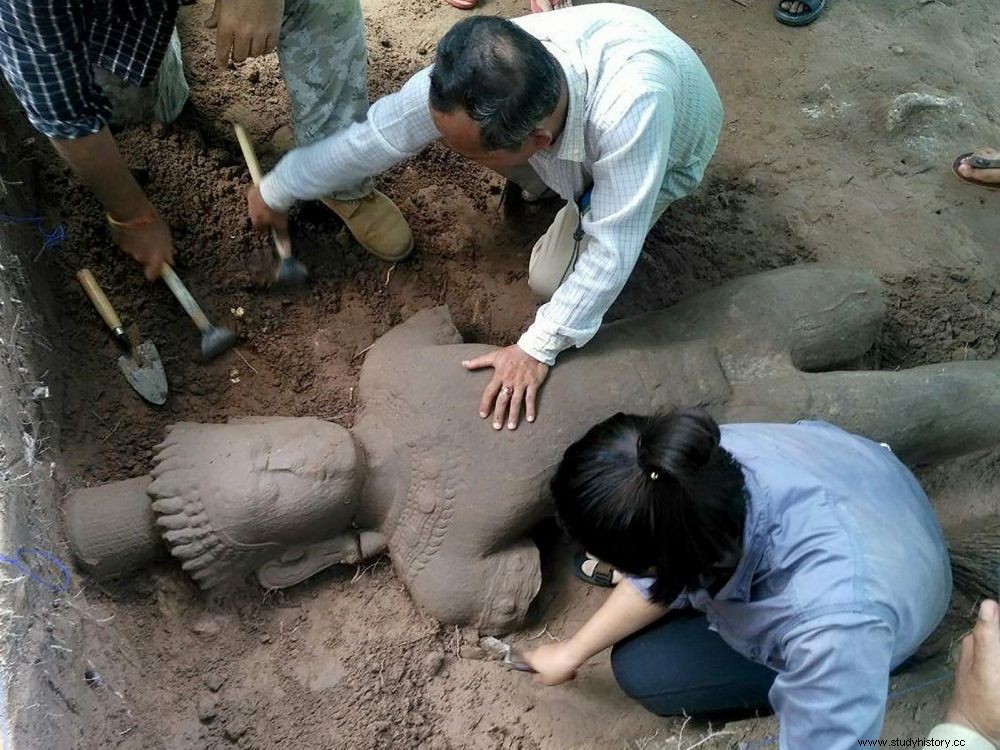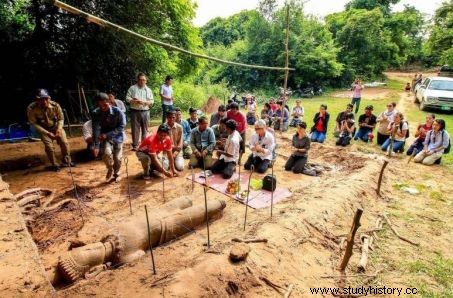An exceptional 12th-13th century sculpture has been unearthed in the temple complex of Angkor, Cambodia.

Discovery of an important statue from the end of the 12th century, on the site of Angkor, in Cambodia.
The surprise was total. No sooner had their second day of work begun than a team of archaeologists discovered an extremely rare statue almost 2m high at the famous site of Angkor, in Cambodia. For years, no work of this magnitude had been found in the city classified as a UNESCO World Heritage Site.

No statue had been unearthed at the Angkor site for years. A small religious ceremony was organized the day after the discovery. © Apsara
An exceptional find
Cut in fine sandstone, the admirable sculpture, which lacks arms and legs, could date from the 12th-13th century. According to those in charge of the excavations, Cambodian archaeologists from the Apsara Authority and the Institute of Asian Studies in South Singapore, it would have been cleared from the side of the north gate of Angkor Thom, the great royal city founded by ruler Jayavarman VII (1125-1218). Each find of this type in Angkor is an event, as the statuary of this former royal capital suffered from looting during (and after) the civil war and the period of the "Khmer Rouge" (1967-1975). Exhumed 40 cm deep, the stone colossus could have been buried during the reign of Jayavarman VIII. At the time, many statues had been buried and concealed to avoid their destruction linked to a movement to restore Brahmanism in the region*. Most of the temples built by the sovereign had been vandalized. In March 2002, a cache containing the fragments of 274 sandstone Buddhist statues had been found by Japanese researchers on the site of Banteay Kdei, a monastic complex east of Angkor, testimony to this moment of religious insurrection.
For Jean-Baptiste Chevance, archaeologist specializing in Cambodia (ADF*) joined by Sciences et Avenir, this sculpture "linked to the Bayon style" - the last of the temple-mountains raised at Angkor - could be "a male deity " and come from one of the hospitals erected by Javayarman VII. " Along the roads of the Khmer empire that linked the city of Angkor to the provinces, "hospitals" had been built to accommodate travellers. Chapels and temples housing statues of deities stood near these buildings ". The imposing discovery could be one of them.
* The Khmer Empire lasted from 802 to 1431, initially under Hindu religious beliefs, until the end of the 12 th century, and later, under Buddhist religious practices.
ADF*:Archeology and Development Foundation, an NGO linking archeology and development.
